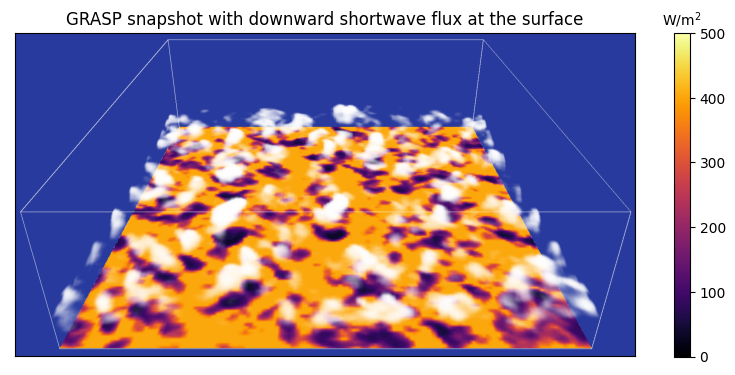Efficient high precision solar radiation in numerical weather prediction

Solar radiation plays an important role in numerical weather prediction (NWP). Accurate radiation profiles are necessary for a realistic simulation of the atmosphere, and a more realistic representation of these profiles can therefore help improve a weather model’s general forecast skill. Moreover, it directly improves the quality of NWP forecasts of solar radiation, for example for the expected local radiative flux, which can be used to predict the power output of solar cells.
Gerwin is a R&D specialist at Whiffle, where he is currently investigating efficient methods to include interactive high resolution, high frequency radiation profiles in the large eddy simulation (LES) model GRASP, characterised by its detailed three-dimensional clouds. The goal is to determine the best possible radiation profiles corresponding to the simulation at any given time, and to feed the resulting fluxes and heating rates back into the model to improve the physical accuracy of the atmospheric simulation.
Radiation profiles are calculated using ECMWF’s radiation scheme ecRad. However, it is computationally too expensive to do this at high resolution and high frequency. To estimate the radiation profiles at the high resolution of the LES model, Whiffle has recently developed an algorithm that severely reduces this computational cost by dividing the vertical columns of the simulation into groups with similar clouds profiles. Early results indicate that this is an excellent approximation of what one would get by explicitly calling ecRad for the entire high resolution domain, but at a small fraction of the computational cost. This also makes it possible to update the radiation profiles at every simulation time step, thus achieving the goal of creating a fully integrated radiation scheme.
Current work focuses on validation of the results by comparing simulation data with measurements and investigating the source of any discrepancies. However, the preliminary results look promising, so this method of implementing solar radiation in NWP has significant potential for the solar power sector.
Figure 1: Snapshot of a GRASP simulation of a domain of 16 km x 16 km x 5 km, with the efficient radiation algorithm enabled. The high-resolution cloud shadows are clearly visible in the surface flux.
More about Gerwin van Dalum
On his background
“I obtained my bachelor’s degree in physics and astronomy in 2013 and my master’s degree in theoretical physics in 2016, both at Utrecht University. Afterwards, I stayed at Utrecht University to pursue a PhD in theoretical condensed matter physics, and I successfully defended my thesis in 2020. Currently, I am working as an R&D specialist at Whiffle, where I am contributing to Whiffle’s large eddy simulation model GRASP.”
On his research interests
“My main research interests involve improving the physics of our GRASP model and investigating new methods to improve numerical weather prediction.”
On choosing Smart4RES and Whiffle for his research
“I am excited to work on Smart4RES at Whiffle because I want to use my skills to contribute to a more sustainable future. Both Smart4RES and Whiffle provide excellent opportunities to make a difference!”
Where he sees himself in 5 years
“I see myself being more and more at home in the field of renewable energy and continue to do what I can to make the world a better place.”

